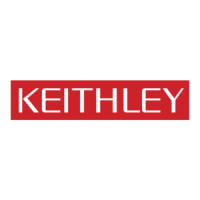11-20 Status Structure Model 2750 Multimeter/Switch System User’s Manual
Queues
The Model 2750 uses two queues, which are first-in, first-out (FIFO) registers:
• Output Queue — Used to hold reading and response messages.
• Error Queue — Used to hold error and status messages.
The Model 2750 status model (Figure 11-1) shows how the two queues are structured with
the other registers.
Output queue
The output queue holds data that pertains to the normal operation of the instrument. For
example, when a query command is sent, the response message is placed in the Output
Queue.
When data is placed in the Output Queue, the Message Available (MAV) bit in the Status
Byte Register sets. A data message is cleared from the Output Queue when it is read. The
Output Queue is considered cleared when it is empty. An empty Output Queue clears the
MAV bit in the Status Byte Register.
A message is read from the Output Queue by addressing the Model 2750 to talk after the
appropriate query is sent.
Error queue
The Error Queue holds error and status messages. When an error or status event occurs, a
message that defines the error/status is placed in the Error Queue.
When a message is placed in the Error Queue, the Error Available (EAV) bit in the Status
Byte Register is set. An error/status message is cleared from the Error Queue when it is
read. The Error Queue is considered cleared when it is empty. An empty Error Queue
clears the EAV bit in the Status Byte Register.
The Error Queue holds up to 10 error/status messages. The commands to read the Error
Queue are listed in Table 11-6. When you read a message in the Error Queue, the “oldest”
message is read and then removed from the queue. If the queue becomes full, the message
“350, ‘Queue Overflow’” will occupy the last memory location. On power-up, the Error
Queue is empty. When empty, the message “0, No Error” is placed in the queue.
Messages in the Error Queue are preceded by a code number. Negative (-) numbers are
used for SCPI-defined messages, and positive (+) numbers are used for Keithley-defined
messages. The messages are listed in the appendices at the end of this manual.
2750-900-01.book Page 20 Wednesday, August 3, 2011 7:56 AM

